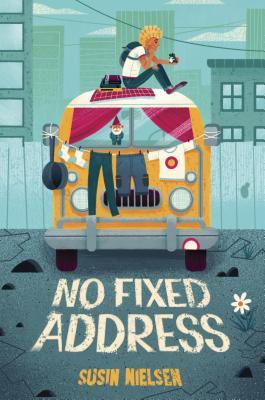No Fixed Address

Maybe you have seen the signs before. A child in your class does not bring a lunch to school. They rarely seem to wear clean clothes. They often seem tired and have difficulty completing work outside of the classroom. They cannot attend field trips and are not able to bring supplies for special projects. Their attendance is erratic and when asked about it, they are evasive. These are all potential signs of homelessness in school age children.
In Canada, 1.3 million children live in poverty. These conditions can have a huge impact on kids, as shown in Susin Nielsen's book No Fixed Address. This middle grade novel tells the story of Felix Knuttson, a boy living in Vancouver who is part of the hidden homeless. Living in a van with his mother, Felix endures the daily stresses of poverty while hiding the truth from others.

No Fixed Address is an excellent book for teaching middle grade students about homelessness and poverty in a way that builds empathy for others. Felix is a relatable character who deals with obstacles as best he can. He encounters all kinds of problems, from hunger and malnutrition, to his mother's depression, to disguising the truth of this living arrangements from his school, friends, and father. Felix and his mother find workarounds for problems, such as going to the library for access to technology or visiting the community centre for showers. He struggles to keep this under wraps and out of the eyes of the authorities, who he fears will remove him from his mother's custody.
The content of the book is presented in a way that is appropriate for middle years, although some sections do hint at the very real dangers posed by homelessness. Things work out for Felix and his mother, but it is easy to see, especially for an adult reader, how quickly this life could become dangerous for them. In fact, Felix catches a few lucky breaks as adults in his life perceive something is wrong and reach out to help him. The book does not stray into discussing adults who do not have Felix's best interests at heart, which in a middle grade book is probably for the best.
No Fixed Address does have the potential to open up dialogue about systemic issues that contribute to homelessness. Some of these are clear, as Nielsen describes the lengthy wait list for public housing and the fear of child and family services that leads Felix's mother to avoid seeking help. In the end, this fear is proven to be unfounded. I am curious how the book would read differently if Felix and his mother were Indigenous, considering the heavy criticisms of the child welfare system by many Indigenous people. It is also worth noting (spoiler warning) that the happy resolution only happens because of the kindness and charity of the adults in Felix's life. A happy ending to be sure, but one that is not available to many families in similar circumstances. Through dialogue, it is important to have students reflect from a systemic standpoint why homelessness and poverty are problems in Canada. No Fixed Address offers an excellent springboard for this discussion.
